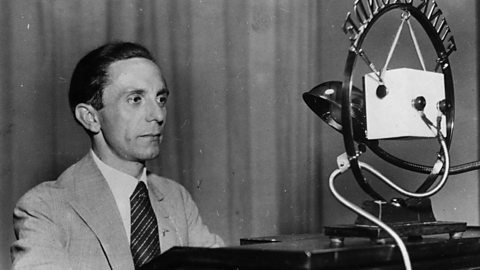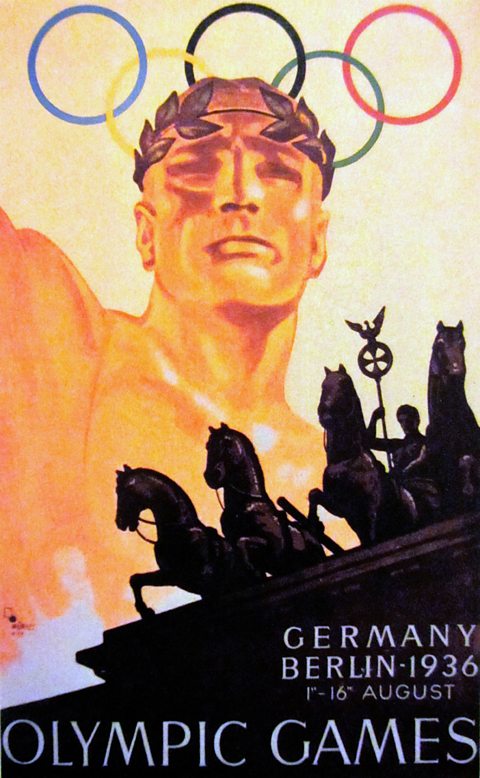The Police State, propaganda and control
The Police State
By August 1934 Hitler was a dictator with absolute power. In order to maintain this power he needed organisations that could control the population to ensure absolute loyalty to the Führer. After the demise of the SAAlso known as Storm Troopers or Brown shirts. A military style organisation of the Nazi party formed in 1921 under Hitler. on the Night of the Long KnivesIn response to demands from the SA to take over the German army, Hitler ordered a purge of his own political party. On 30 June 1934, the SS murdered around 400 members of the SA, including Röhm and a number of other opponents like the previous Chancellor, von Schleicher., there were three main interlinked organisations (in addition to the regular German police force) involved in controlling the German people through spying, intimidation and, if necessary, imprisonment:
- Schutzstaffel (SS) - Led by Heinrich Himmler, the SS was the most important of these organisations and oversaw the others. Initially set up as HitlerвҖҷs personal bodyguard service, the SS was fanatically loyal to the FГјhrer. It later set up concentration camps where вҖҳenemies of the stateвҖҷ were sent
- Gestapo - This was the NazisвҖҷ secret police force. Its job was to monitor the German population for signs of opposition or resistance to Nazi rule. It was greatly helped by ordinary German people informing on their fellow citizens.
- Sicherheitsdienst (SD) - This was the intelligence gathering agency of the SS. It was responsible for the security of Hitler and other top Nazis and was led by ұбҫұіҫіҫұфұр°щвҖҷs right hand man, Reinhard Heydrich.
Revision tip:
A good mnemonic to help you remember some of the key features of this topic is:
- ұбҫұіҫіҫұфұр°щвҖҷs - Head of the police state
- Sight вҖ“ The SS
- Gradually вҖ“ The Gestapo
- Spreads вҖ“ The SD
Nazi control of the legal system
The Nazis quickly swept away many of the freedoms that Germans had enjoyed under the Weimar constitution. The partyвҖҷs control of the legal system made opposition to the regime very difficult indeed:
- Judges had to swear an oath of loyalty to Hitler and were expected to act always in the interests of the Nazi state.
- All lawyers had to join the Nazi Lawyers' Association, which meant they could be controlled.
- The role of defence lawyers in criminal trials was weakened.
- Standard punishment for crimes were abolished and so local prosecutors could decide what penalties to impose on those found guilty.
These changes more than halved the number of criminal offences between 1933 and 1939, whilst the number of crimes that carried the death penalty increased from three to 46. Many convicted criminals were not released at the end of their sentences but instead were moved to the growing number of concentration camps being established by the SS.
Goebbels and the Ministry of Propaganda

Hitler and the Nazi Party were a constant presence in the life of the German people, with:
- The infamous Swastika symbol appearing on every government uniform and public building.
- Pictures of Hitler displayed everywhere.
- Germans having to greet each other with a вҖҳHeil HitlerвҖҷ raised arm salute.

The government department responsible for all of this was the Ministry of Enlightenment and Propaganda, headed by Dr Joseph Goebbels. It aimed to brainwash people into obeying the Nazis and idolising Hitler. Its methods included:
- Censorship of the press. All newspapers were controlled by the government and could only print stories favourable to the Nazi regime.
- Control of radio broadcasts. Radios were sold very cheaply so that most Germans could afford one. All radio output was controlled by GoebbelsвҖҷ ministry through the Reich Broadcasting Corporation.
- Mass rallies. These public displays of support for Nazism involved music, speeches and demonstrations of German strength. The biggest one was held each year in August at Nuremberg.
- Use of sports events. Berlin hosted the Olympics of 1936, which the Nazis used as an opportunity to showcase the success of the regime and to demonstrate the superiority of the AryanA person of European descent - not Jewish - often with blond hair and blue eyes. The Nazis viewed Aryans as the superior human race. race. The victories of the African-American athlete Jesse Owens for the USA infuriated the Nazi leadership.
Loudspeakers in public places also blared out Nazi propaganda. Much of the information Germans received reinforced the message of Aryan racial superiority whilst demonising the Jews and other вҖҳenemiesвҖҷ of the regime.
Nazi control of culture and the arts
| Type | German influence |
| Art | The Weimar period had seen a flourishing of German art, much of which was abstract. Hitler saw this modern art as вҖҳdegenerateвҖҷ and over 6500 works of art were removed from display across Germany. Hitler encouraged вҖҳAryan artвҖҷ instead, which showed the physical and military power of Germany and the Aryan race. |
| Architecture | Hitler was very interested in architecture and believed it could be used to project the power of the Nazi regime. The most important architect of the period was Albert Speer, who redesigned Berlin, as well as designing the stadium in Nuremberg where annual rallies were held. |
| Literature | Nazis ceremonially burned thousands of books in 1933 that were viewed as being subversive or as representing ideologies opposed to Nazism. These included books written by Jewish, pacifist, classical, liberal, anarchist, socialist, and communist authors. |
| Theatre | Works by certain playwrights were banned. Nazi-produced political plays and musicals were not very popular so the regime allowed classic plays by the likes of Shakespeare to be performed. |
| Film | To make sure that film served the goals of propaganda, the Nazi Party gradually took over film production and distribution. A state-run professional school for politically reliable film-makers was founded, and membership of an official professional organization (Reichsfilmkammer) was made compulsory for all actors and film-makers. The Nazi leaders often used film stars, like Lil Dagover, to help promote the popularity of the party in Germany. |
| Music | In classical music, works by Jewish composers like Mendelssohn and Mahler were banned and the works of the German composer Wagner were promoted, gaining huge popularity. The Nazis were strongly opposed to jazz music, which they referred to as 'Negro music' and called it 'degenerate'. |
| Art | |
|---|---|
| German influence | The Weimar period had seen a flourishing of German art, much of which was abstract. Hitler saw this modern art as вҖҳdegenerateвҖҷ and over 6500 works of art were removed from display across Germany. Hitler encouraged вҖҳAryan artвҖҷ instead, which showed the physical and military power of Germany and the Aryan race. |
| Architecture | |
|---|---|
| German influence | Hitler was very interested in architecture and believed it could be used to project the power of the Nazi regime. The most important architect of the period was Albert Speer, who redesigned Berlin, as well as designing the stadium in Nuremberg where annual rallies were held. |
| Literature | |
|---|---|
| German influence | Nazis ceremonially burned thousands of books in 1933 that were viewed as being subversive or as representing ideologies opposed to Nazism. These included books written by Jewish, pacifist, classical, liberal, anarchist, socialist, and communist authors. |
| Theatre | |
|---|---|
| German influence | Works by certain playwrights were banned. Nazi-produced political plays and musicals were not very popular so the regime allowed classic plays by the likes of Shakespeare to be performed. |
| Film | |
|---|---|
| German influence | To make sure that film served the goals of propaganda, the Nazi Party gradually took over film production and distribution. A state-run professional school for politically reliable film-makers was founded, and membership of an official professional organization (Reichsfilmkammer) was made compulsory for all actors and film-makers. The Nazi leaders often used film stars, like Lil Dagover, to help promote the popularity of the party in Germany. |
| Music | |
|---|---|
| German influence | In classical music, works by Jewish composers like Mendelssohn and Mahler were banned and the works of the German composer Wagner were promoted, gaining huge popularity. The Nazis were strongly opposed to jazz music, which they referred to as 'Negro music' and called it 'degenerate'. |
The NazisвҖҷ interest in and influence on all of these areas demonstrates the extent to which the party sought to control German life and win over the population to the Nazi cause.